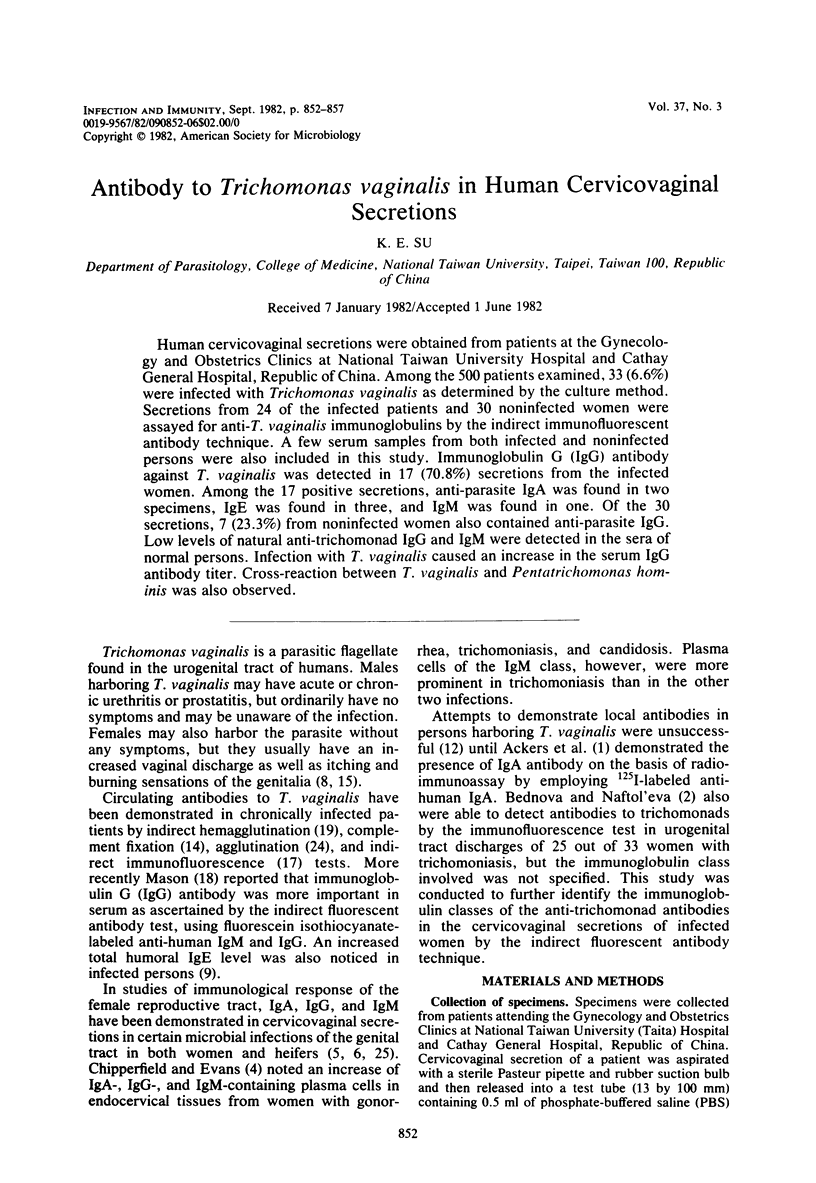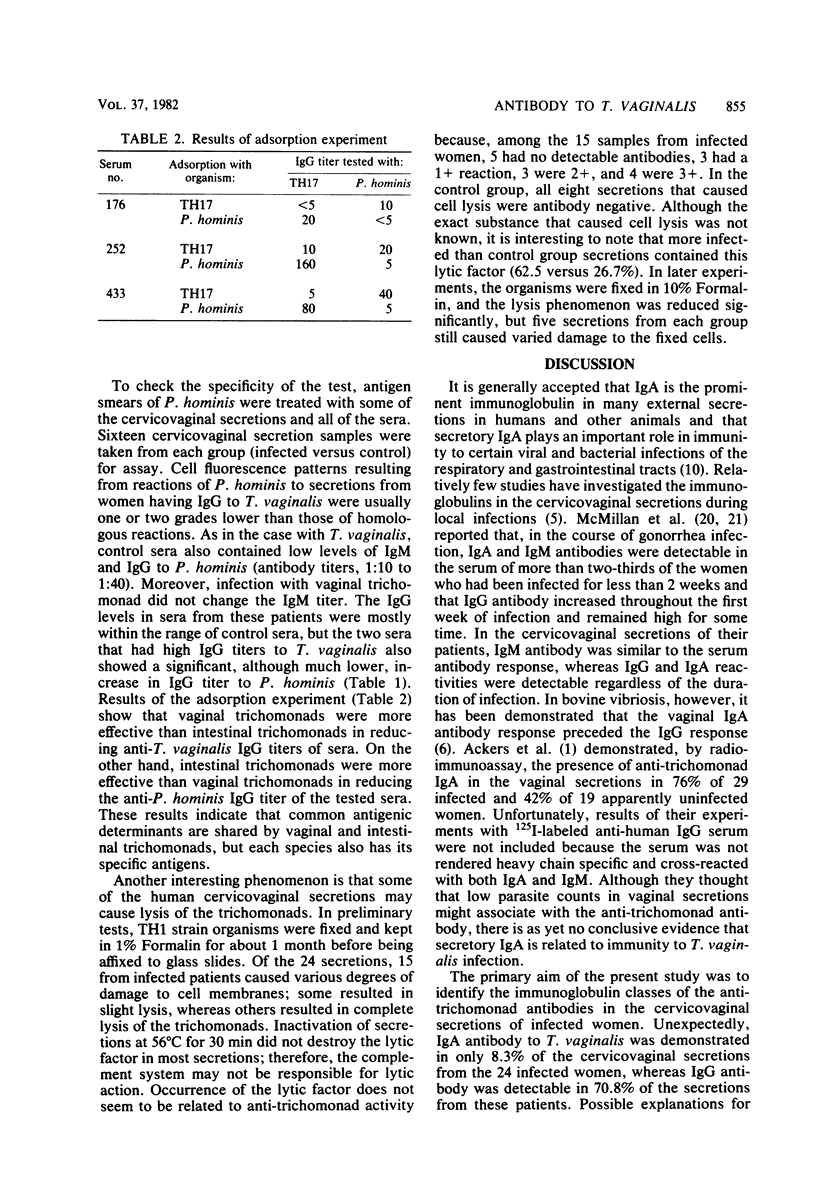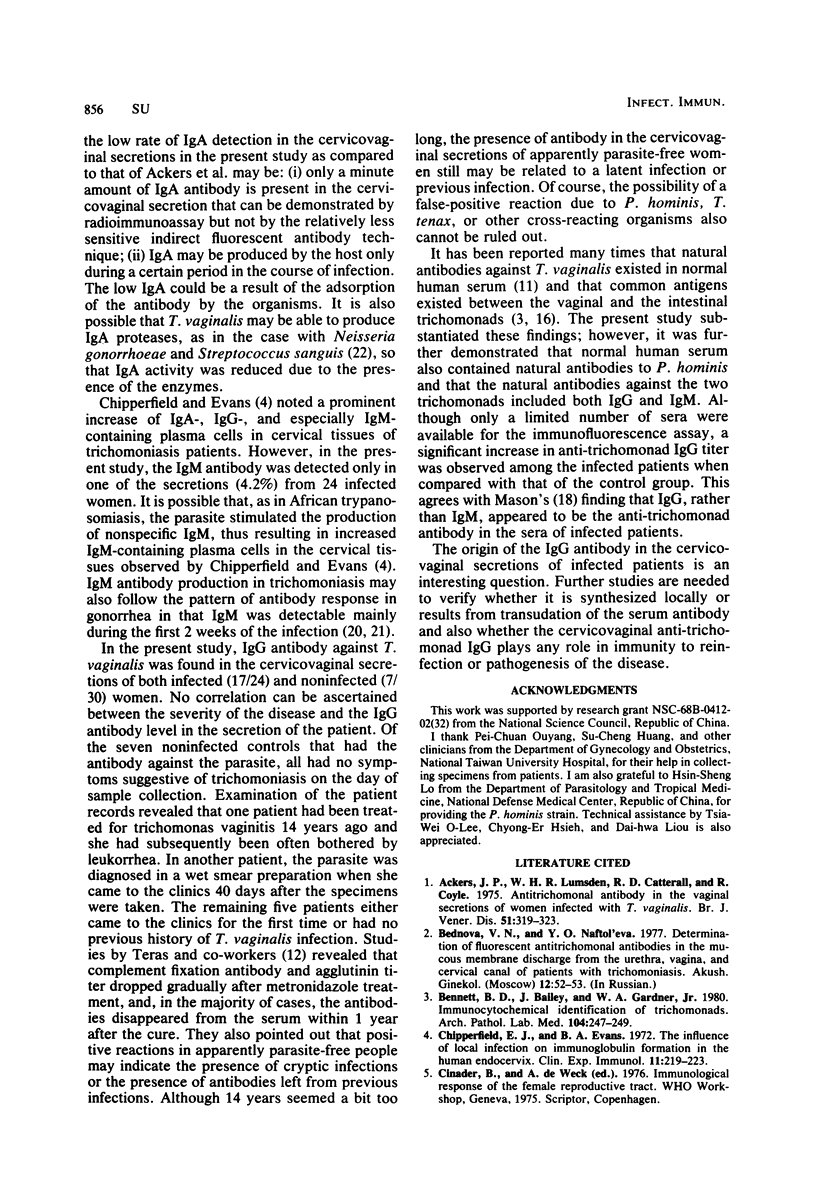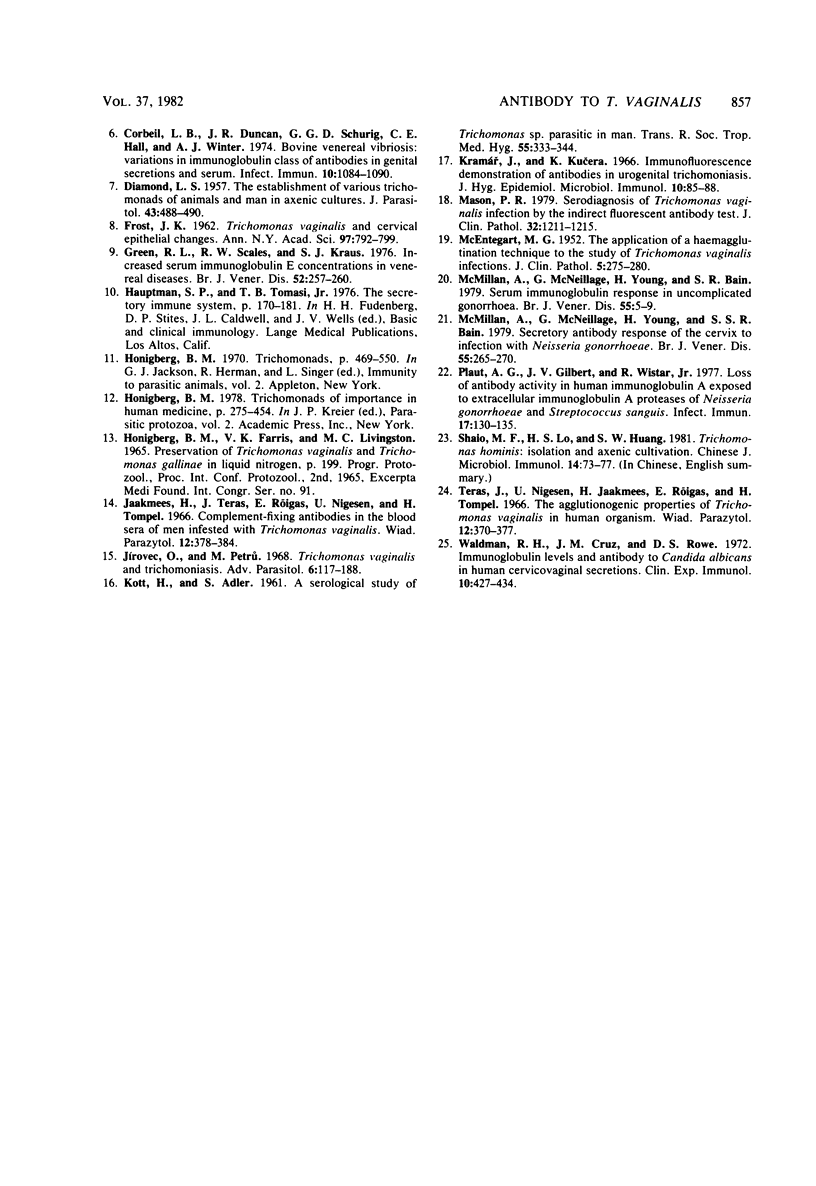Abstract
Human cervicovaginal secretions were obtained from patients at the Gynecology and Obstetrics Clinics at National Taiwan University Hospital and Cathay General Hospital, Republic of China. Among the 500 patients examined, 33 (6.6%) were infected with Trichomonas vaginalis as determined by the culture method. Secretions from 24 of the infected patients and 30 noninfected women were assayed for anti-T. vaginalis immunoglobulins by the indirect immunofluorescent antibody technique. A few serum samples from both infected and noninfected persons were also included in this study. Immunoglobulin G (IgG) antibody against T. vaginalis was detected in 17 (70.8%) secretions from the infected women. Among the 17 positive secretions, anti-parasite IgA was found in two specimens, IgE was found in three, and IgM was found in one. Of the 30 secretions, 7 (23.3%) from noninfected women also contained anti-parasite IgG. Low levels of natural anti-trichomonad IgG and IgM were detected in the sera of normal persons. Infection with T. vaginalis caused an increase in the serum IgG antibody titer. Cross-reaction between T. vaginalis and Pentatrichomonas hominis was also observed.
Full text
PDF





Selected References
These references are in PubMed. This may not be the complete list of references from this article.
- Ackers J. P., Lumsden W. H., Catterall R. D., Coyle R. Antitrichomonal antibody in the vaginal secretions of women infected with T. vaginalis. Br J Vener Dis. 1975 Oct;51(5):319–323. doi: 10.1136/sti.51.5.319. [DOI] [PMC free article] [PubMed] [Google Scholar]
- Bennett B. D., Bailey J., Gardner W. A., Jr Immunocytochemical identification of trichomonads. Arch Pathol Lab Med. 1980 May;104(5):247–249. [PubMed] [Google Scholar]
- Chipperfield E. J., Evans B. A. The influence of local infection on immunoglobulin formation in the human endocervix. Clin Exp Immunol. 1972 Jun;11(2):219–233. [PMC free article] [PubMed] [Google Scholar]
- Corbeil L. B., Duncan J. R., Schurig G. G., Hall C. E., Winter A. J. Bovine venereal vibriosis: variations in immunoglobulin class of antibodies in genital secretions and serum. Infect Immun. 1974 Nov;10(5):1084–1090. doi: 10.1128/iai.10.5.1084-1090.1974. [DOI] [PMC free article] [PubMed] [Google Scholar]
- DIAMOND L. S. The establishment of various trichomonads of animals and man in axenic cultures. J Parasitol. 1957 Aug;43(4):488–490. [PubMed] [Google Scholar]
- FROST J. K. Trichomonas vaginalis and cervical epithelial changes. Ann N Y Acad Sci. 1962 Sep 29;97:792–799. doi: 10.1111/j.1749-6632.1962.tb34689.x. [DOI] [PubMed] [Google Scholar]
- Green R. L., Scales R. W., Kraus S. J. Increased serum immunoglobulin E concentrations in venereal diseases. Br J Vener Dis. 1976 Aug;52(4):257–260. doi: 10.1136/sti.52.4.257. [DOI] [PMC free article] [PubMed] [Google Scholar]
- Jírovec O., Petrů M. Trichomonas vaginalis and trichomoniasis. Adv Parasitol. 1968;6:117–188. doi: 10.1016/s0065-308x(08)60473-x. [DOI] [PubMed] [Google Scholar]
- KOTT H., ADLER S. A serological study of Trichomonas sp. parasitic in man. Trans R Soc Trop Med Hyg. 1961 Jul;55:333–344. doi: 10.1016/0035-9203(61)90102-x. [DOI] [PubMed] [Google Scholar]
- Kramár J., Kucera K. Immunofluorescence demonstration of antibodies in urogenital trichomoniasis. J Hyg Epidemiol Microbiol Immunol. 1966;10(1):85–88. [PubMed] [Google Scholar]
- Mason P. R. Serodiagnosis of Trichomonas vaginalis infection by the indirect fluorescent antibody test. J Clin Pathol. 1979 Dec;32(12):1211–1215. doi: 10.1136/jcp.32.12.1211. [DOI] [PMC free article] [PubMed] [Google Scholar]
- McENTEGART M. G. The application of a haemagglutination technique to the study of Trichomonas vaginalis infections. J Clin Pathol. 1952 Aug;5(3):275–280. doi: 10.1136/jcp.5.3.275. [DOI] [PMC free article] [PubMed] [Google Scholar]
- McMillan A., McNeillage G., Young H., Bain S. R. Serum immunoglobulin response in uncomplicated gonorrhoea. Br J Vener Dis. 1979 Feb;55(1):5–9. doi: 10.1136/sti.55.1.5. [DOI] [PMC free article] [PubMed] [Google Scholar]
- McMillan A., McNeillage G., Young H., Bain S. S. Secretory antibody response of the cervix to infection with Neisseria gonorrhoeae. Br J Vener Dis. 1979 Aug;55(4):265–270. doi: 10.1136/sti.55.4.265. [DOI] [PMC free article] [PubMed] [Google Scholar]
- Plaut A. G., Gilbert J. V., Wistar R., Jr Loss of antibody activity in human immunoglobulin A exposed extracellular immunoglobulin A proteases of Neisseria gonorrhoeae and Streptococcus sanguis. Infect Immun. 1977 Jul;17(1):130–135. doi: 10.1128/iai.17.1.130-135.1977. [DOI] [PMC free article] [PubMed] [Google Scholar]
- Shaio M. F., Lo H. S., Huang S. W. [Trichomonas hominis: isolation and axenic cultivation (author's transl)]. Zhonghua Min Guo Wei Sheng Wu Ji Mian Yi Xue Za Zhi. 1981 Jun;14(2):73–77. [PubMed] [Google Scholar]
- Waldman R. H., Cruz J. M., Rowe D. S. Immunoglobulin levels and antibody to Candida albicans in human cervicovaginal secretions. Clin Exp Immunol. 1972 Mar;10(3):427–434. [PMC free article] [PubMed] [Google Scholar]


